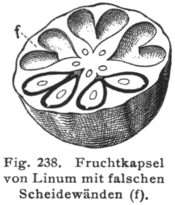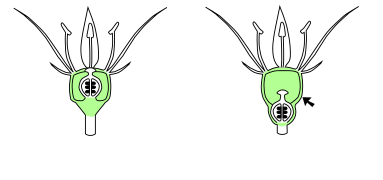Ovary

fs stalk-like base of the ovary, fu funiculus , cha chalaza, nu nucellus , mi micropyle , ii inner integument , ie outer integument, e embryo sac , ek core of the embryo sac, egg apparatus , an antipode, g stylus , n stigma , p pollen grains , ps pollen tubes
(48x magnification)

1 cup shaped flowers ground (receptaculum) of the flower cups or Hypanthium forms
the second sepals (sepals)
3 petals (petals)
4. stamens (stamens)
5. Stamp ( Pestle)

As ovaries or ovary is referred to in the Botany the bulbous portion of the punch , a unit of a gynoecium , in which the up ovule with the eggs located. There is an ovary only in the common flowering plant . After fertilization of the ovum by the generative nucleus of the pollen tube to the ovary develops in ovule embryo , of the seed is enclosed. The pulp often develops from the ovary wall as the fruit ripens, as in the case of cherries .
description
A ovary consists of a (monomeric) ( mono- unicarp , uni- einkarpellat) or several (polymer, poly-, multikarpellat) fused ( coenokarpen , verwachsenblättrigen) carpels with free or fused styluses . The position of the ovules in the ovary is called placentation .
An ovary can be single-faced, single-chambered, not chambered (not; primary / only weakly, moderate; secondary coenocarp and paracarp fanned out by septa , septa ). The lysicarpic ovary is a special form , here the septa of a coeno-syncarpic ovary are dissolved and only a free central placentation remains.
Apparently single-carpel but multi-carpel and coenocarpic ovary, gynoecea, are referred to as pseudo-monomeric . They can arise from secondary reduction of carpels and they are often unicameral. With the reduction of carpels and ovules , sterile compartments can also arise in coenocarpic gynoecea, and only the fertile ones then have one or more ovules and the others are stunted.
An ovary can also be fanned out or compartmentalized ( coenocarp and synkarp ; completely subdivided with real partitions or holo-coenocarp, eu- or primary synkarp). Are the real partitions Karpellränder in the center of the ovary free from each other, it is incomplete septate ( hemi, secondary-synkarp , -coenokarp , -parakap ).
In an ovary there can be more or less fanned and / or unfanned areas in sections or there can be different placentations as in the case of the pomegranate . The carpels are often synkarp in the basal area, but paracarp farther distal, which is why a distinction is no longer made between coeno-parakarp and -synkarp, but only all coenocarp ovaries are generally referred to as synkarp.
Both monomeric and polymeric ovaries can also have more or less developed false partitions ; d. H. Form growth from the surface of the carpels or from the placental tissue. A continuous column (columella) can also form in the middle of the ovary.
Several free-leaved carpels that are not grown together can also be present at the same time (apocarp also eu-apocarp or chorikarp ).
Several partially overgrown ovaries can also be present at the same time. It is possible that the adjacent carpels are only partially, just overgrown with free styles (hemi-apocarpous, semicarpous) or are connected by the flower base (pseudo-coenocarp). Two or more ovaries of different flowers can rarely be wholly or partially fused to form a syngynium (pseudo-monomeric), as in the honeysuckle or batis .

a androeceum , g stamp
I. above, II. half below, III. subservient
It can septal nectaries , septum nectaries ; Sunken nectaries can be formed on the contact surfaces of adjacent carpels with a duct to the outside. Nectaries can also be present on the outside of the ovary. Nectaries can also occur on the stylus cushion . Scar secretions can also take on a nectar function.
position
A distinction is made between different shapes depending on the position of the ovary and shape in the flower base :
- The upper ovary (hypogynous) stands on a flattened flower base or, more rarely, on the edge, mouth of a cup-shaped flower base, and the calyx , corolla and stamens start below the ovary. The flower base can also be designed with an internode , which lifts the ovary; gynophore , androgynophore and flower-bearing (anthophore).
- In the semi-subordinate (semi-protruding) ovary (epihypogyn, half-, hemi-epigyn, perigyn) this is fused in its lower half with the relatively short flower cup (hypanthium), while in the upper half it is free. The remaining parts of the flower arise in the middle of the ovary, on the edge of the hypanthium.
- The middle ovary (perigyn) is free, mostly at the base or, more rarely, on the walls of a cup-shaped flower base (flower cup, hypanthium) without growing together with it. The remaining parts of the flower arise from the edge of the hypanthium, which surrounds the ovary. Whereby this form is sometimes seen as standing on top.
- The ovary below (epigyn) is sunk into the base of the flower (hypanthium) and fused with it (gynoeceal hypanthium) and the remaining parts of the flower begin above the ovary. But it can also be fused below the hypanthium (epiperigyn); gynoeceales and perigynes hypanthium, as in the cucurbits or the opuntia . Or a strongly elongated hypanthium can attach above the lower ovary , as in the evening primrose ( Oenothera ), then this is also called hypanepigynous .
- A mixture of middle and semi-underneath ovary (epihypoperigyn) is also possible. Here the half-fused, semi-underneath ovary above the middle with the flower base (flower cup, hypanthium) is covered with a free hypanthium, the remaining parts of the flower arise from the edge of the hypanthium.
Special forms
A stalked ovary (stipitate) is not the same as a gyno-, androgyno- or anthophoric, here a narrowed basal part of the ovary forms a smaller stalk or a podium. This ovary stalk is prop foot called or Podogynium, Gynopodium. If the foot or the handle is disc-shaped, it is called a gyno base (stamp pad, floor), and this can correspond to a nectar-exuding disc . The carpophor , the fruit holder , which comes from the ovary and / or the flower base, is also different .

A carpopodium is also possible , this is a differently shaped, more or less hard "structure" ( callus , podocarp) below the ovary of the daisy family . The basal demolition zone, the anchor point of the fruit ( achenes ). This structure is to be regarded as different.
The receptaculum also grows with an internode gynophor, androgynophor and flower-bearing (anthophor). A special shape is the formation of the flower base as a stamen carrier (androphoric), here the stamens are above and the sepals and petals are below the hypanthium. The ovary can be arranged differently here. The staminophore, which occurs in the eucalyptus and the myrtle family , has a special shape ; a special band of tissue is formed on the hypanthium, which acts as a stamen carrier.
literature
- Peter Sitte , Elmar Weiler , Joachim W. Kadereit , Andreas Bresinsky , Christian Körner : Textbook of botany for universities . Founded by Eduard Strasburger . 35th edition. Spektrum Akademischer Verlag, Heidelberg 2002, ISBN 3-8274-1010-X .
- Peer Schilperoord: Plasticity of the flower base and the ovary - underdevelopment. In: Elements of Science. 99, 2013, pp. 21–36, online (PDF; 2.72 MB), at urpflanze.ch, accessed on June 7, 2017.
- Michael G. Simpson: Plant Systematics. Academic Press, 2006, ISBN 0-12-644460-9 .
Individual evidence
- ↑ Ernst Hallier : School of systematic botany. WG Korn, 1878, p. 62, archive.org . - Not to be confused with monocarpid plant.
- ↑ Birgit Gemeinholzer: Systematics of plants compact. Springer, 2018, ISBN 978-3-662-55233-9 , p. 158 f.
- ^ E. Strasburger , P. Sitte , H. Ziegler : Textbook of botany for universities. 34th edition, Fischer, 1998, ISBN 3-437-25500-2 , p. 727.
- ↑ Joachim W. Kadereit a. a .: Strasburger - Textbook of Plant Sciences. 37th edition, Springer, 2014, ISBN 978-3-642-54434-7 , p. 159.
- ^ Notes from the Royal Botanic Garden, Edinburgh. Vol. 25-26 1963 / 64-1964 / 66, pp. 385 f, 391, 395-398, 400.
- ^ Focko Weberling : Morphology of Flowers and Inflorescences. Cambridge Univ. Press, 1989, 1992, ISBN 0-521-25134-6 , p. 152 ff.
- ↑ Thomas Stützel: Botanical determination exercises. 3rd edition, Ulmer, 2015, ISBN 978-3-8252-8549-4 , p. 38 f.
- ↑ RC McLean, WR Ivimey-Cook: Textbook of theoretical botany. Vol. II, Longmans, Greene, 1956, pp. 1241 f, archive.org .
- ↑ Albert E. Radford et al. a .: Fundamentals of plant systematics. Harper & Row, 1986, ISBN 0-06-045305-2 , p. 426, In: Albert E. Radford et al. a .: Vascular Plant Systematics. Harper & Row, 1974, ISBN 0-06-045309-5 , Chapter 6 Phytography 1, Fig. 6.11.1, online at Academia.edu , accessed May 22, 2019.
- ↑ Peer Schilperoord.
- ↑ Michael G. Simpson: p. 377.
- ↑ Achille Richard : New outline of botany and plant physiology. 2nd edition, Schrag, 1831, p. 281, Munich Digitization Center (MDZ) .
- ^ Gottlieb Wilhelm Bischoff : Textbook of Botany. Schweizerbart, 1839, p. 155, online at biodiversitylibrary.org, accessed on May 22, 2018.
- ↑ Emmanuel Le Maout , Joseph Decaisne : A General System of Botany Descriptive and Analytical. Longmans, Green, 1876, p. 70.
- ^ Gottlieb Wilhelm Bischoff : Textbook of Botany. Swiss Beard, 1839, p. 92.
- ↑ Nádia Roque, David J. Keil, Alfonso Susanna: Illustrated glossary of Compositae. 2009, in: VA Funk u. a .: Systematics, evolution, and biogeography of Compositae. International Association for Plant Taxonomy, University of Vienna, 2009, ISBN 978-3-9501754-3-1 , Appendix A, online (PDF) at researchgate.net, accessed May 29, 2018.
- ^ MZ Haque, MBE Godward: New records of the carpopodium in Compositae and its taxonomic use. In: Botanical Journal of the Linnean Society. 89, 1989, pp. 321-340, doi: 10.1111 / j.1095-8339.1984.tb02564.x .







